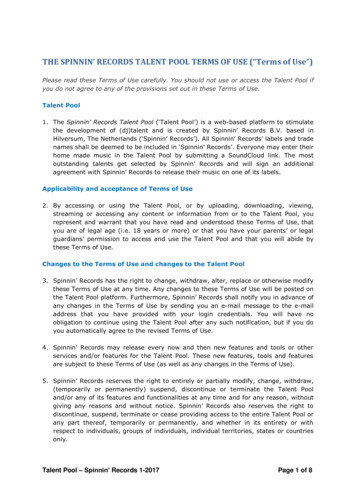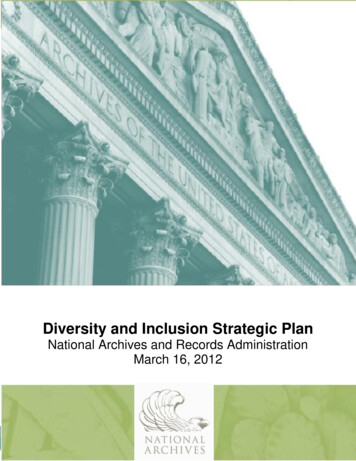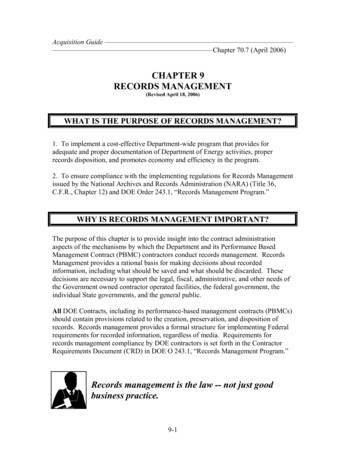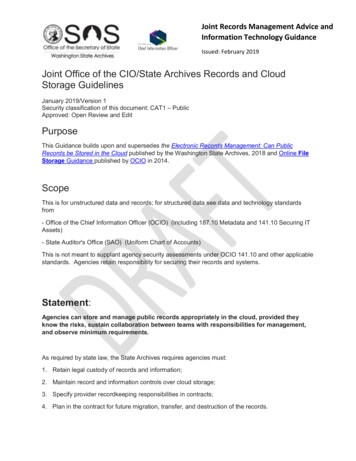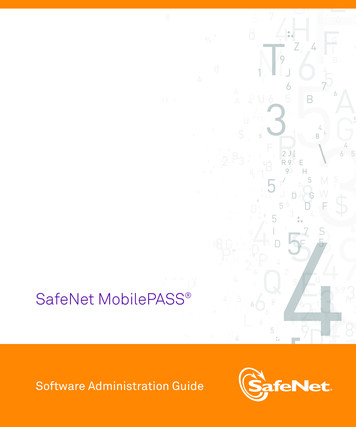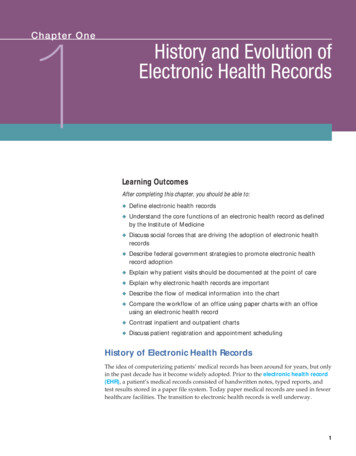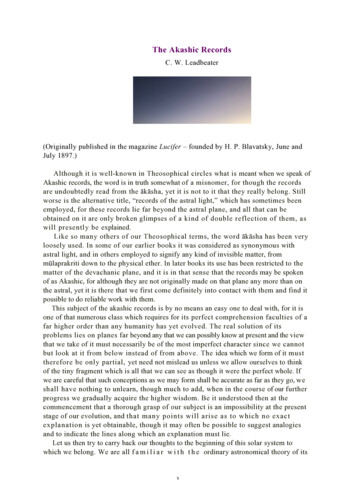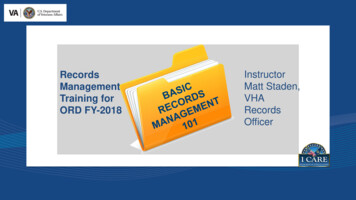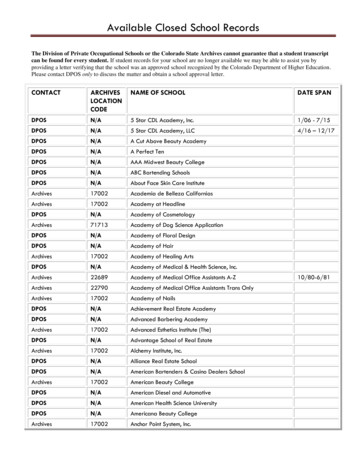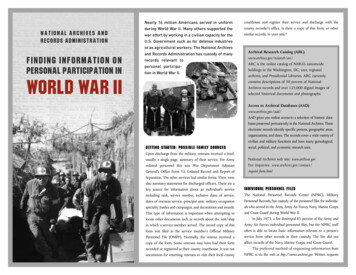
Transcription
Nearly 16 million Americans served in uniformduring World War II. Many others supported thenational archives andrecords administrationwar effort by working in a civilian capacity for thecourthouse and register their service and discharge with thecounty recorder’s office. Is there a copy of this form, or othersimilar records, in your attic?U.S. Government such as for defense industriesor as agricultural workers. The National Archivesand Records Administration has custody of manyFinding Information onPersonal Participation inrecords relevant topersonal participa tion in World War II.World War IIGetting Started: Possible Family SourcesUpon discharge from the military, veterans received a brief,usually a single page, summary of their service. For Armyenlisted personnel this was War Department AdjutantGeneral’s Office Form 53, Enlisted Record and Report ofSeparation. The other services had similar forms. There werealso summary statements for discharged officers. These are akey source for information about an individual’s serviceincluding rank, service number, inclusive dates of service,dates of overseas service, principal unit, military occupationspecialty, battles and campaigns, and decorations and awards.This type of information is important when attempting tolocate other documents such as records about the unit/shipin which a service member served. The record copy of thisform was filed in the service member’s Official MilitaryPersonnel File (OMPF). Normally, the veteran received acopy of the form. Some veterans may have had their formrecorded or registered at their county courthouse. It was notuncommon for returning veterans to visit their local countyArchival Research Catalog (ARC)www.archives.gov/research/arc/ARC is the online catalog of NARA’s nationwideholdings in the Washington, DC, area, regionalarchives, and Presidential Libraries. ARC currentlycontains descriptions of 50 percent of NationalArchives records and over 125,000 digital images ofselected historical documents and photographs.Access to Archival Databases (AAD)www.archives.gov/aad/AAD gives you online access to a selection of historic data bases preserved permanently in the National Archives. Theseelectronic records identify specific persons, geographic areas,organizations, and dates. The records cover a wide variety ofcivilian and military functions and have many genealogical,social, political, and economic research uses.National Archives web site: www.archives.govFor inquiries: al Personnel FilesThe National Personnel Records Center (NPRC), MilitaryPersonnel Records, has custody of the personnel files for individu als who served in the Army, Army Air Forces, Navy, Marine Corps,and Coast Guard during World War II.In July 1973, a fire destroyed 85 percent of the Army andArmy Air Forces individual personnel files, but the NPRC staffoften is able to locate basic information relevant to a person’sservice from other records in their custody. The fire did notaffect records of the Navy, Marine Corps, and Coast Guard.The preferred method of requesting information fromNPRC is via the web at http://vetrecs.archives.gov. Written requests
may be submitted on Standard Form 180 (SF 180), RequestPertaining to Military Records. This form and other infor mation about NPRC can be found athttp://archives.gov/ veterans/military service-records/get-service-records.html.The National Personnel Records Center,Civilian Personnel Records (CPR), has per sonnel files for individuals who worked forthe U.S. Government as civilian workers.War Production Board files of the so-called“Dollar-a-Year” men are in the custody ofCPR. Specific information on how to accessthese files is available at equests for personnel information on MerchantMarine seamen from World War II should be submitted tothe U.S. Coast Guard, National Maritime Center, Director(NMC-4A), 4200 Wilson Boulevard, Suite 510, Arlington,VA 22203-1804.Participation in the MilitaryWorld War II Military Unit / Ship RecordsThe National Archives has most records of Army, Army AirForces, Marine Corps, and Navy units and ships that foughtin World War II. These records vary in arrangement, con tent, and completeness, but all focus on documentingunit/ship organization and operations. Only rarely do theyinclude information about named individuals. In order tosearch these records, you will need to know the exact des ignation of the unit/ship in which the service memberserved (e.g., Company A, 16th Infantry, 1st Division;249th Engineer Combat Battalion; 1921st QuartermasterTruck Company; or USS Missouri) and the approximatedates of service.Army and Marine Corps unit records include a varietyof document types, including unit histories (narratives or col lections of documents), after action reports, unit journals (usu ally a log of messages sent and received by a unit), and orders,including general orders issued by a unit indicating individu als who received a decoration or award. For the Army AirForces, we have combat operations records (“mission reports”)for some units (mostly for bomber and fight er groups that fought in Europe) that provideoperational details on missions flown againsta specific target or on a particular day.Operations of Navy ships and other activ ities are documented through deck logs ofships and other craft afloat, which containinformation about ship movements andadministration for each of the six daily fourhour watches. Ships, aviation units, taskorganizations, and shore stations also pre pared monthly war diaries (usually daily narrativeentries, but not as detailed as ship deck logs) and action reports(prepared only after a significant combat action).Records of Navy ships crewed by Coast Guard personneland serving as part of Navy task organizations are in ModernMilitary Records. Logbooks, muster rolls, and other records ofCoast Guard vessels and stations, operated solely as a CoastGuard function, are in the Coast Guard records in Old Militaryand Civil Records.Merchant Marine RecordsA merchant marine casualty file can be found in RG26, Deceased and War Casualty Seaman’s Records,1937–50, located at the NationalArchives Building in Washington,DC. This series is arranged alpha betically and may provide deathdate, name of vessel, applica tion of seaman’s certificates,copy of telegram announc ing death, certificates ofdischarge from vessels,next-of-kin informa tion, and a photo graph of the seaman.The logbooksdocument the namesand assignments of crew members, drills conducted duringthe voyage, brief descriptions of situations and events andsome personnel-related information. Some of the regionalarchives hold official merchant marine logbooks for portsserved by that region. Some have declassified merchantmarine “secret logbooks” from 1942–45, that may containmore specific information than the official logbooks. Also,a national regional database, available at most of ourregional archives, provides vessel names and voyage datesfor various ports.Army Enlistment RecordsThe electronic database of World War II ArmyEnlistment Records contains approximately 9 millionrecords of men and women who enlisted in the Armybetween 1938 and 1946. It does not include records forofficers or for all enlistees. There are known gaps in thecoverage of this database (some records could not beconverted to a digital form) and in the data withinrecords for some individuals. The enlistment recordscontain basic information about the individual, includingservice number, name, residence, place and date of enlist ment, and year of birth. The records are accessiblethrough AAD at www.archives.gov/aad and by click ing on the link “World War II.”
Records of the Selective Service System, 1926–71,Draft Registrations (of the Fourth Registration)Selective Service records for individuals who served dur ing World War II (except for fourth registration cards)are in the custody of the Records Division, SelectiveService System, 1515 Wilson Boulevard, Arlington, VA22209-2425. The person’s full name, date of birth, andlegal address at the time of registration should be in cluded in your request. There are two types of records:ledgers and cards. The ledgers are in the public domainand not restricted by privacy. The cards are consideredpersonal information and written permission for release,a death certificate, and/or an indication the informationis requested for genealogical purposes should accompa ny the request for copies of the cards.World War II Selective Service System draft registra tion cards for men born April 28, 1877, through February16, 1897 (known as the Fourth Registration), are availablefrom our regional facilities. Each card has information suchas the individual’s name, address, date and place of birth,signature, race, height, andweight. Using thesearch phrase“Fourth Registration,” consult ARC at www.archives.gov/research/arc for more information.Prisoner-of-War (POW) RecordsAbout 130,000 American service members were capturedby the enemy during World War II. The National Archiveshas records that list the names of individual POWs. Tosearch records in our custody, a researcher needs to have thename of the POW, rank, service number, and approximatedate and place of capture.In addition, the electronic records series Records of WorldWar II Prisoners of War contains about 143,000 records ofU.S. military personnel and U.S. and Allied civilians who wereheld as prisoners of war or internees by Japanese or Germanpowers. The record for each individual includes informationsuch as name, serial number, detaining power, POW or intern ment camp, report date, and unit. The electronic records seriesWorld War II Prisoners of the Japanese Data File contains someadditional information compiled by a volunteer organizationabout prisoners of war held by the Japanese. Both series ofrecords are accessible through AAD at www.archives.gov/aad andby clicking on the link “World War II.”Casualty FilesThere is considerable documentation among many different seriesof records in the National Archives relating tocasualties, but normally it is very difficult tolocate information about a specific individualcasualty. One notable exception pertains toArmy Air Forces personnel whose planecrashed or was shot down whileon operational missions. Beginning in June 1943, such individ ual losses were documented by a “missing aircrew report”(MACR) prepared by the unit to which the individual wasassigned. Name, rank, service number of one or more crew mem bers, or aircraft serial (tail) number is needed to search the seriesof MACRs in the National Archives. However, these records arealso limited in that at least 30 percent of all operational losses arenot documented by a MACR. Also a MACR documents onlylosses on combat missions when the plane came down in nonfriendly territory.Service numbers for men killed in action and who servedin the Army or the Army Air Forces can be found in the WorldWar II casualty lists available through ARC at www.archives.gov/research/arc/ww2/.The Federal Government provides headstones for deceasedmembers and veterans of the U.S. Armed Forces when a familymember has applied for one. Applications for Headstones,1925–63, for U.S. Army personnel are in the custody of theNational Archives and include the name of the deceased, unitdesignation, serial number, dates of service, date of death, andplace of burial. To search these records, a researcher needs toknow the year the application was made and the name of thedeceased. Using the search phrase “Applications for Headstonesand Army,” consult ARC at www.archives.gov/research/arc/ formore information.Individual casualty files exist for serv ice members who died while on activeduty. The custodian of these records forArmy personnel is the Army Casualty andMemorial Affairs Operation Center, U.S.Army Human Resources Command,TAPC-PED, 2461 Eisenhower Avenue,Alexandria, VA 22331-0482. Navy files areat the Military Medical Support Office, Mortuary Affairs Section,P.O. Box 886999, Great Lakes, IL 60088-6999. Informationabout Marine Corps casualties can be obtained from the Office ofManpower and Reserve Affairs, Headquarters Marine Corps,3280 Russell Avenue, Quantico, VA 22134-5103.
Records on Other Topics Related to“Personal Participation”Cadet Nurse Corps FilesIn June 1943, Congress passed the Bolton Act, whichset up the Cadet Nurse Corps program in the PublicHealth Service (RG 90). Cards were kept for each cadetand include the name of the cadet, where and when sheattended nursing school, where and when she complet ed her training, hometown, and how she learned aboutthe program. In order to search the cards, the requesterneeds to provide the state, city, and name of the nursingschool. As of this date, former Cadet Nurses have notreceived military recognition by Congress and are noteligible for veterans’ benefits.Japanese Internment and Relocation RecordsSeveral sources of information concerning JapaneseAmerican families interned during World War II are listedon the National Archives web site at cans.html. There is also anelectronic database of Japanese American internees evacuat ed from Washington, Oregon, and Cali fornia and sent to relocation centers. It issearchable by name and can be accessedthrough the National Archives web pageat http://aad.archives.gov/ aad/ then clickon “World War II.”Civilian Participation at HomeSince the civilian defense structure dur ing World War II was largely voluntary,the administrative records in NARA cus tody do not include files on or lists ofvolunteers such as air raid wardens, etc.If your family member worked ina factory or defense plant during thewar, the National Archives may havecustody of files relating to these com panies, but these files rarely includeinformation about individual workers.Rationing was an essential part of the war effort onthe home front. Although the National Archives has copiesof blank ration books and other forms and informationconcerning rationing, our holdings do not include recordsof recipients.Presidential PapersThe Presidential Libraries of Franklin D. Roosevelt, Harry S.Truman, and Dwight D. Eisenhower have rich collections relat ed to World War II, including materials on personal participa tion. The holdings of these Libraries include letters from indi vidual soldiers and sailors and their family members; documentson awards, medals, and citations requiring Presidential approval;and letters of condolence from the President to the families ofselect servicemen. In its World War II Participants and Con temporaries collection, the Eisenhower Library has over 80,000pages of personal papers, diaries, printed material, and photo graphs of veterans who served overseas or on the home front.For a list of all Presidential Libraries, go to braries.html.Special Media Records Pertainingto the Second World WarThe Second World War became the first U.S. conflict to bedocumented visually through the use of film and photogra phy on a large scale. Waves of U.S. Government photogra phers and artists risked and, at times, gave their lives in cap turing the most defining moments of the war, leaving thepublic with a legacy of millions of photographs and images.Combat footage and newsreels were used to document allaspects of the war, while propaganda and training films wereproduced to generate support for the war amongst militaryinductees and the civilian population. The rapid accelerationof the use of aerial photography for military operations andintelligence gathering led the Army Map Service to producethousands of detailed, topographic maps for areas of theworld never before surveyed by the United States.RIP 70, A Finding Aid to Audiovisual Records in theNational Archives of the United States Relating to World War II,provides an excellent overview of still pictures, sound record ings, and motion picture films found within NARA’s hold ings by record group. RIP 70 may be accessed online /index.html.RIP 79, World War II Records in the Cartographic andArchitectural Branch of the National Archives, provides detailedinformation on the varied holdings of aerial photographs, archi tectural drawings, charts, engineering plans, maps,and ship plans found within NARA. RIP 79may be accessed online at ndex.pdf.The majority of special media records pertain ing to the Second World War are located in theNational Archives at College Park, Maryland.Presidential Libraries also have some audiovisualmaterials and artifacts pertaining to World War II.Instructions on how to search for selected spe cial media items through NARA’s ArchivalResearch Catalog (ARC) may be found special-media. Selected digital images may be down loaded via ARC.
Other Repositories U.S. Army Military History Institute, 950 Soldiers Drive, Carlisle, PA 17013-5008. www.carlisle.army.mil/ahec/MHI.htm. Its holdings include published and unpublished histories of many Army units, as well as surveys, ques tionnaires, and personal papers of World War II veterans. Air Force Historical Research Agency, 600 Chennault Circle, Maxwell Air Force Base, AL 36112.www.maxwell.af.mil/au/afhra/. This is the repository for Army Air Forces unit histories and supporting docu mentation. National World War II Museum, 923 Magazine Street, New Orleans, LA, 70130. www.ddaymuseum.org/.Formerly the D-day Museum, its mission is to honor the World War II generation. Center for the Study of War and Society, Hoskins Library, University of Tennessee, Knoxville, TN 37996.www.lib.utk.edu/spcoll/searchms/ ww2index.html. The center collects diaries, letters, and other papers of individual serv ice members, with particular emphasis on World War II. Veterans History Project, Library of Congress, Washington, DC 20540. www.loc.gov/vets/. The core of itscollections contains oral histories of veterans, particularly from World War II.Useful Guides Jonathan Gawne, Finding Your Father’s War: A Practical Guide to Researching and Understanding Service in the World War IIUS Army (Philadelphia, PA: Casemate, 2006). This only relates to the Army but includes historical information as wellas practical, how-to tips; also see the related web site at www.fatherswar.com. Richard S. Johnson, How To Locate Anyone Who Is or Has Been in the Military: Armed Forces Locator Directory (SanAntonio, TX: Military Information Enterprises Publishing, 1993). Not limited to World War II but it is multi service and has contact information for military veteran and reunion groups. Debra Johnson Knox, World War II Military Records: A Family Historian’s Guide (Spartanburg, SC: MIE Publishing,2003). This includes an especially useful compilation of state, local, and private repositories holding documen tary material relating to World War II.NARA Contact InformationWorld War II Military Unit/Ship Records:Modern Military Records (NWCTM)National Archives at College Park8601 Adelphi RoadCollege Park, MD 20740-6001Merchant Marine andCoast Guard Log Books:Old Military and Civil RecordsNational Archives Building700 Pennsylvania Avenue, NWWashington, DC 20408-0001Individual Personnel Files–Civilian:National Personnel Records CenterCivilian Personnel Records (CPR)111 Winnebago StreetSt. Louis, MO 63118-4126Still Pictures, Cartographic, andMotion Pictures (specify the branch):Special Media Division (NWCSC)National Archives at College ParkRoom 33208601 Adelphi RoadCollege Park, MD 20740-6001Individual Personnel Files–Military:National Personnel RecordsCenter (NPRC)Military Personnel Records9700 Page AvenueSt. Louis, MO 63132-5100For a list of all National Archives loca tions: www.archives.gov/locations
In addition, the electr onic records series Records of World War II Prisoners of War contains about 143,000 records of U.S. military personnel and U.S. and Allied civilians who were held as prisoners of war or internees by Japanese or German po
